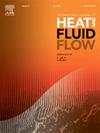Thermal-hydrodynamic analysis for internally interrupted-finned tubes: Experimental, numerical and performance study
IF 2.6
3区 工程技术
Q2 ENGINEERING, MECHANICAL
International Journal of Heat and Fluid Flow
Pub Date : 2024-11-22
DOI:10.1016/j.ijheatfluidflow.2024.109665
引用次数: 0
Abstract
The characteristics of fluid flow and heat transfer in an internally interrupted-finned tube were studied, experimentally and numerically, and a performance evaluation study was conducted in the present research. The numerical results were validated with the current experimental data as well as other published data, with a maximum deviation of 8.93 %. The effect of different key parameters like fin height, number of fin-rows, fin thickness and number of fins in each row on the thermal-hydrodynamic performance was explored. This study reveals that increasing both fin height and number of fin-rows raises the heat transfer coefficient and friction factor values, but fin thickness negligibly affects the performance. Notably, the average heat transfer coefficient value rises by 25.03 % if the fin height to diameter ratio is increased from 0.1786 to 0.4018, and by 21.4 % if the number of fins is increased from 2 to 6, compared to finless tubes under a mass flow rate of 0.39 kg/s, for three number of fins per row. Compared to the continuously finned tubes, the interrupted-finned tubes have higher heat transfer coefficient values if the interruption length is equal to or less than the fin length, while these values are reduced below that of the continuously finned if the interruption length is larger than the fin length. Clearly, when the interruption length is 3 times the fin length, the heat transfer coefficient value of the continuously finned tube is higher than that of the interrupted-finned one by 3.1 %, while the heat transfer coefficient value of the interrupted-finned tube is higher than that of the continuously finned one by 13.59 %, when the interruption length is reduced to one-third of the fin length. It is recommended using the interrupted-finned tubes over the smooth ones if the amount of mass flow rate flowing through both tubes is the same, but the use of interrupted-finned tubes is not recommended as opposed to smooth ones if both tubes are subjected to the same pressure drop across them.
内部间断翅片管的热流体力学分析:实验、数值和性能研究
本研究通过实验和数值方法研究了内部间断翅片管中的流体流动和传热特性,并进行了性能评估研究。数值结果与当前的实验数据以及其他已公布的数据进行了验证,最大偏差为 8.93%。研究还探讨了不同关键参数,如鳍片高度、鳍片排数、鳍片厚度和每排鳍片数量对热流体力学性能的影响。研究表明,增加翅片高度和翅片排数可提高传热系数和摩擦因数值,但翅片厚度对性能的影响微乎其微。值得注意的是,在质量流量为 0.39 千克/秒、每排翅片数量为 3 的条件下,如果翅片高度与直径之比从 0.1786 增加到 0.4018,平均传热系数值将比无翅片管提高 25.03%;如果翅片数量从 2 增加到 6,平均传热系数值将提高 21.4%。与连续翅片管相比,当间断长度等于或小于翅片长度时,间断翅片管的传热系数值较高,而当间断长度大于翅片长度时,传热系数值则低于连续翅片管。显然,当间断长度是翅片长度的 3 倍时,连续翅片管的传热系数值比间断翅片管的传热系数值高 3.1%,而当间断长度减小到翅片长度的三分之一时,间断翅片管的传热系数值比连续翅片管的传热系数值高 13.59%。如果流过两根管子的质量流量相同,建议使用间断翅片管,而不是光滑翅片管;但如果两根管子上的压降相同,则不建议使用间断翅片管,而不是光滑翅片管。
本文章由计算机程序翻译,如有差异,请以英文原文为准。
求助全文
约1分钟内获得全文
求助全文
来源期刊

International Journal of Heat and Fluid Flow
工程技术-工程:机械
CiteScore
5.00
自引率
7.70%
发文量
131
审稿时长
33 days
期刊介绍:
The International Journal of Heat and Fluid Flow welcomes high-quality original contributions on experimental, computational, and physical aspects of convective heat transfer and fluid dynamics relevant to engineering or the environment, including multiphase and microscale flows.
Papers reporting the application of these disciplines to design and development, with emphasis on new technological fields, are also welcomed. Some of these new fields include microscale electronic and mechanical systems; medical and biological systems; and thermal and flow control in both the internal and external environment.
 求助内容:
求助内容: 应助结果提醒方式:
应助结果提醒方式:


